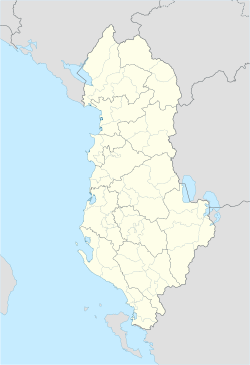Kranë (Albanian definite form: Krana; Greek: Κρανιά; romanized Kraniá) is a village in Vlorë County, southern Albania.[1] At the 2015 local government reform it became part of the municipality of Finiq.[2] It is inhabited solely by Greeks.[3]
Kranë
Κρανιά | |
|---|---|
| Coordinates: 39°53′29″N 20°05′23″E / 39.89139°N 20.08972°E | |
| Country | |
| County | Vlorë |
| Municipality | Finiq |
| Elevation | 65 m (213 ft) |
| Time zone | UTC+1 (CET) |
| • Summer (DST) | UTC+2 (CEST) |
History
editIn antiquity it was an Epirote town, known as "Elikranon" (Greek: Ελίκρανον).[4] The ancient ruins can be seen even today. The name "Krania" is firstly mentioned in the Chronicle of the Tocco in 1412.[5] In 1856, the Greek scholar Panagiotis Aravantinos writes about the village:[6] «... a village with 15 houses, of Greek origin, the spoken language is Greek and belongs to the diocese of Delvino.»[6]
In 1925-1926, the village had a Greek school with 50 students and 1 teacher.[7] During World War II the village was burnt by Albanian partisans.[8]
Thimios Lolis (1880-1961) was born in the village, a Greek chieftain who fought in the Macedonian Struggle in the group of Pavlos Melas, the Autonomous Republic of Northern Epirus, the Balkan Wars and in the Greco-Italian War.[9][10] A monument to honour him exists in the village. Between 2018-19, the Thimios Lolis monument was vandalized twice by Albanian nationalists.[11][12]
Demographics
editIn the Ottoman defter of the Sanjak of Delvina from 1431-1432, 4 villages in the area of Vurgu are recorded: Finiki (Finiqi), Vurgo, Jeromi and Krajna, each with very few inhabitants. Among these villages, in the Ottoman register mentioned above typical Albanian names are attested, such as: Gjin, Reçi, Leka, Gjon, Dorza, Meksh Nika and Deda.[13]
Kranë (Krajna) is again recorded in the Ottoman register of 1520 as a settlement in the Sanjak of Delvina with a total of 19 households, the vast majority of attested household heads bearing typical Albanian anthroponyms: Gjin Ilia; Bardh Kola; Gjon Pelegri; Tole Dhima; Gjin Pelegri; Jorgji Kasneci; Nikolla Murojet; Golem Sirpopi; Bardh Lopci; Lekë Lopci; Teodor Istrozi; Martin Gjoni; Martin Kasneci; Dhimo Gjini; Kosta Kalici; Gjon Marini; Kosta Kosta; Deda Gjoni; Gjin Kasneci.[14]
Kranë is subsequently attested in the defter of 1583 in the Sanjak of Delvina where its size had decreased to 9 households, the vast majority of attested household heads bearing Albanian anthroponyms: Gjin Gjoni; Dhimo Gjon Pope; Pope Gjin Pope; Dhimo Kondi; Bard Kondi; Gjon Gjini; Ogos (possibly, Ivgos) Dhimo; Qirko Dhimo; Dhimo Gjini.[15]
According to a research of 1993, the village had a permanent population of 854, of which all were ethnically Greeks.[3]
Notable people
edit- Thimios Lolis (Greek: Θύμιος Λώλης; 1880-1961) Greek chieftain who fought in the Macedonian Struggle, the Balkan Wars, the Struggle for Northern Epirus and the Greco-Italian War[9][10]
References
edit- ^ "Location of Kranë".
- ^ "Law nr. 115/2014" (PDF) (in Albanian). p. 6376. Retrieved 25 February 2022.
- ^ a b Kallivretakis, Leonidas (1995). "Η Ελληνική Κοινότητα της Αλβανίας υπό το Πρίσμα της Ιστορικής Γεωγραφίας και Δημογραφίας [The Greek Community of Albania in Terms of Historical Geography and Demography]" (in Greek). Εκδόσεις Σιδέρης. p. 55. Retrieved 2 February 2015.
- ^ Κ. Παπαρρηγοπούλου, "Ιστορία του Ελληνικού έθνους". vol 2. publication of National Geographic Society, 2009-2010.
- ^ E. Zachariadou, "The first thousand verses in the beginning of the Chronicle of the Tocco (Ε. Ζαχαριάδου, «Οι χίλιοι στίχοι στην αρχή του Χρονικού των Τόκκων»), Ipirotika Chronika (Ηπειρωτικά Χρονικά) 15 (1983) 158-181 (in Greek)
- ^ a b Panagiotis Aravantinos, Χρονογραφία της Ηπείρου : των τε ομόρων ελληνικών και ιλλυρικών χωρών διατρέχουσα κατά σειράν τα εν αυταίς συμβάντα από του σωτηρίου έτους μέχρι του 1854., Εκ του Τυπογραφείου Σ. Κ. Βλαστού, Athens 1856 (in Greek)
- ^ Μαντά, Ε. (2005). Όψεις της ιταλικής επίδρασης στη διαμόρφωση των ελληνοαλβανικών σχέσεων κατά την περίοδο του μεσοπολέμου Αριστοτέλειο Πανεπιστήμιο Θεσσαλονίκης (ΑΠΘ). Σχολή Φιλοσοφική. Τμήμα Ιστορίας και Αρχαιολογίας. Τομέας Νεότερης και Σύγχρονης Ιστορίας και Λαογραφίας. p. 48
- ^ Οικονομικός Ταχυδρόμος (in Greek). Δημοσιογραφικός Οργανισμός Λαμπράκη. 1997. p. 46.
Τα χωριά Κρανιά, Πέπελη, Σωπική, Σμίνετσι, Λαζάτες, Αλίκο, Γριάζανη, Μουζίνα, Δρόβιανη κάηκαν, ύστερα από προβοκατόρικη επίθεση του αλβανικού ΕΑΜ κατά των Γερμανών.
- ^ a b Θύμιος Λώλης: Ποιος ήταν ο θρυλικός οπλαρχηγός της Ηπείρου και γιατί ενοχλεί τους Αλβανούς [Thimios Lolis: Who was the legendary chieftain of Epirus and why Albanians are bothered of him], 4 December 2018, iellada
- ^ a b Menikos, Σπυρίδων (2018). Ηλιοφόρος Ρωμιός (in Greek). AKAKIA Publications. p. 71. ISBN 978-1-912322-92-3.
Καπετάνιος Θύμιος Λώλης 1880- 1961 από την Κρανιά της Βορείου Ηπείρου. Μακεδονομάχος πλάι στον Παύλο Μελά. Διακρίθηκε για τη συμμετοχή του στον Μακεδονικό Αγώνα, τους Βαλκανικούς Πολέμους και τον Βορειοηπειρωτικό αγώνα.
- ^ Albanian nationalists vandalise Greek monument in Northern Epirus, 4 December 2018, Daily Hellas
- ^ Albanians vandalize again Greek monument as they try to terrorize the Greek minority (photos) (Upd.), 23 July 2019, Protothema
- ^ Demiraj, Shaban (2008). "La situation ethnique-linguistique des habitants de Dropulli et de Vurgu au cours des siecles". Studia Albanica. 1. Academy of Sciences of Albania: 77–91. ISSN 0585-5047.
- ^ Delvina, Sherif (2003). Epirus, Low Albania (PDF). Tiranë: Eurorilindja. p. 193. ISBN 99927-815-4-8.
- ^ Buharaja, Vexhi (1992). "Kazaja e Delvinës (Nga defteri osman i sanxhakut të Delvinës i vitit 1583)". Studime Historike (1–4): 177.
